
I am not a whore, I am the whore, and for you: Mrs. Whore,by CaldodeCultivo was a context-specific project that sought to create shared experiences for the production of self-representations that appeal to the respect and dignity of trans sex workers in the Santa Fe district, the so-called "zone of tolerance" of Bogotá (red light district). This project ws proposed as a tool for the visibility and consolidation of the symbolic and cultural territory of the Santa Fe district, from the perspective of sex workers.
I am not a whore, I am the whore, and for you: Mrs. Whore, is a provocation to debate, an affirmation of autonomy, a demand
I am not a whore, I am the whore, and for you: Mrs. Whore, is a provocation to debate, an affirmation of autonomy, a demand
for visibility and respect. A tool in defense of a conquered territory —the Santa Fe district— and against the victimizing, signaling or exoticizing discourses, which between crime and sin depoliticize subjects who practice sex work.
Making use of different artistic languages, the project moved from the intimate to the public, generating ever-wider spaces for dialogue and creation. First, through a live arts workshop, we investigate the meanings of the phrase and the most personal memories and desires. Later we carried out a cartography to address the history of urban transformations in the center of Bogotá from the perspective of trans whores,
Making use of different artistic languages, the project moved from the intimate to the public, generating ever-wider spaces for dialogue and creation. First, through a live arts workshop, we investigate the meanings of the phrase and the most personal memories and desires. Later we carried out a cartography to address the history of urban transformations in the center of Bogotá from the perspective of trans whores,
who identified monuments, bars, hotels, cinemas, and patrimonial residences for whoring from personal tours. We closed this first stage by exploring the territory with a four-night video dèrive through the Santa Fe district. As a climax, two public events were produced installing the neon sign; a cultural take over of a brothel and the street on the border that separates the neighborhood to the city, and an exhibition.
Exercise of Video Dérive
—
For four nights we accompanied the participants in their usual work in the Santa Fe neighborhood. We had previously agreed on what kind of representations they wanted for themselves and they prepared aesthetically for it. The agreed idea was to produce powerful representations of trans sex workers, away from the usual gaze as powerless victims or perverters of society. Everything else was improvised. The exercise ended up becoming a kind of nocturnal dèrives by the Sant Fe confiners.
—
For four nights we accompanied the participants in their usual work in the Santa Fe neighborhood. We had previously agreed on what kind of representations they wanted for themselves and they prepared aesthetically for it. The agreed idea was to produce powerful representations of trans sex workers, away from the usual gaze as powerless victims or perverters of society. Everything else was improvised. The exercise ended up becoming a kind of nocturnal dèrives by the Sant Fe confiners.













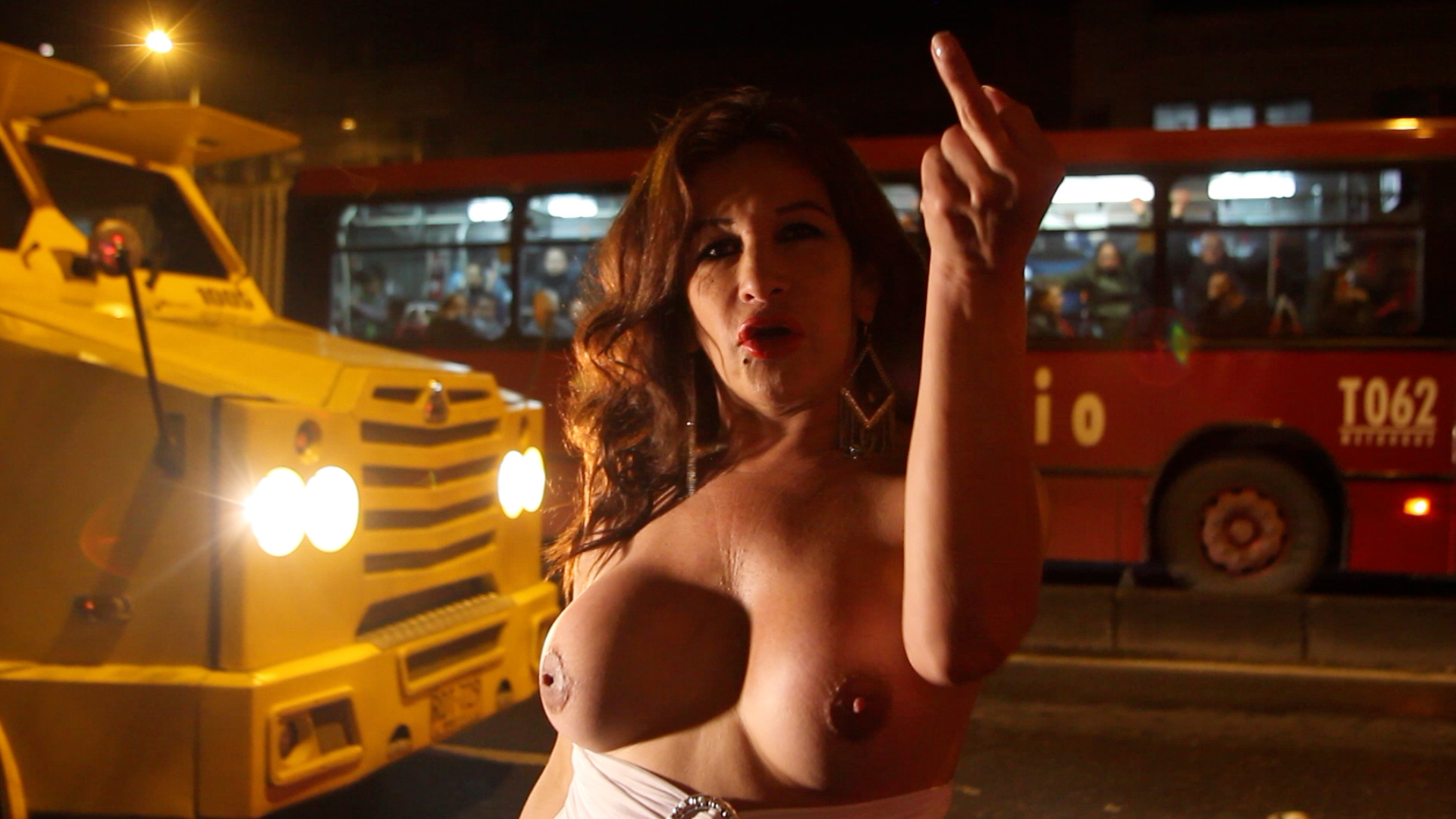

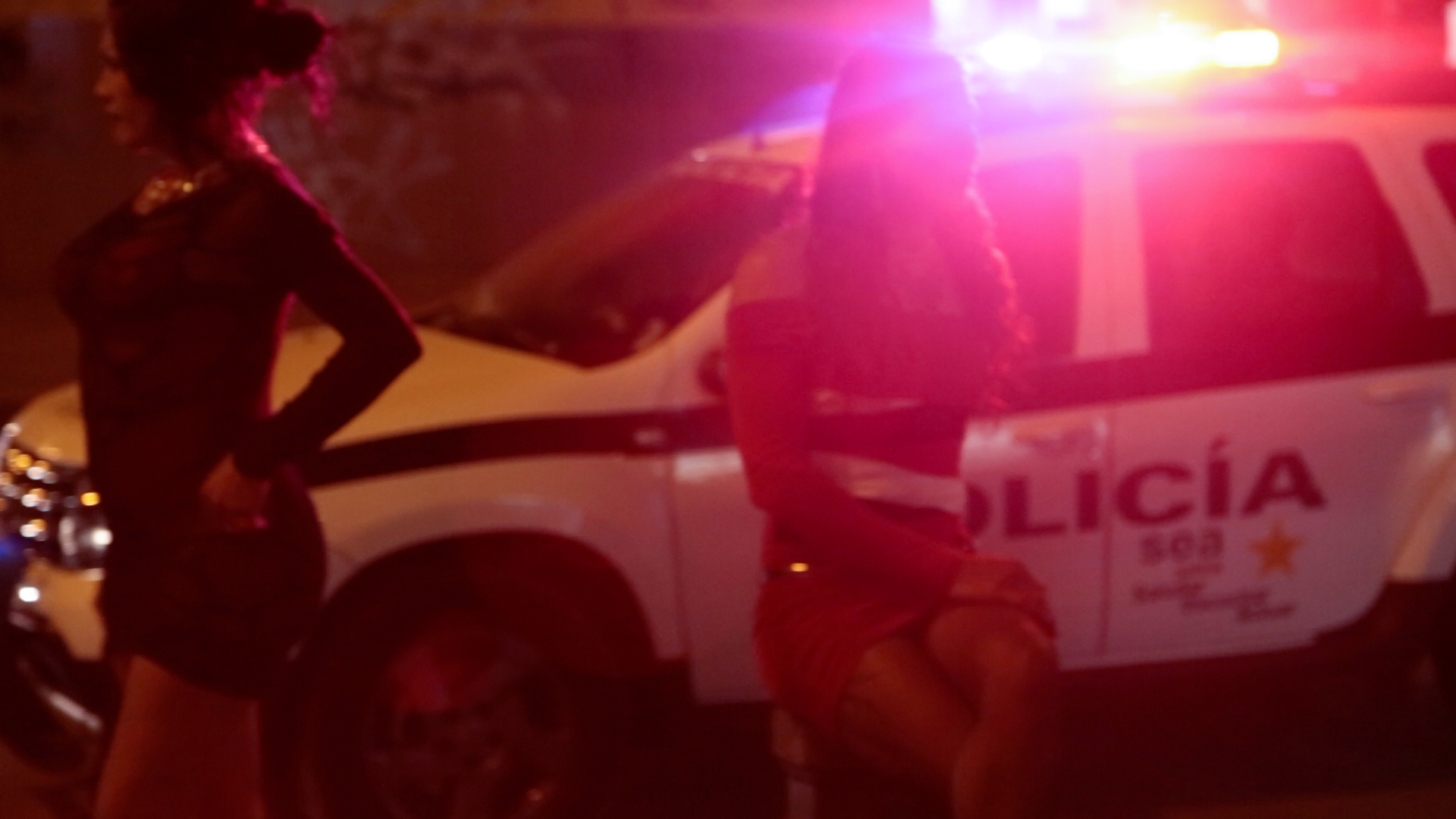



The Take-Over of a Whorehouse and the public space:















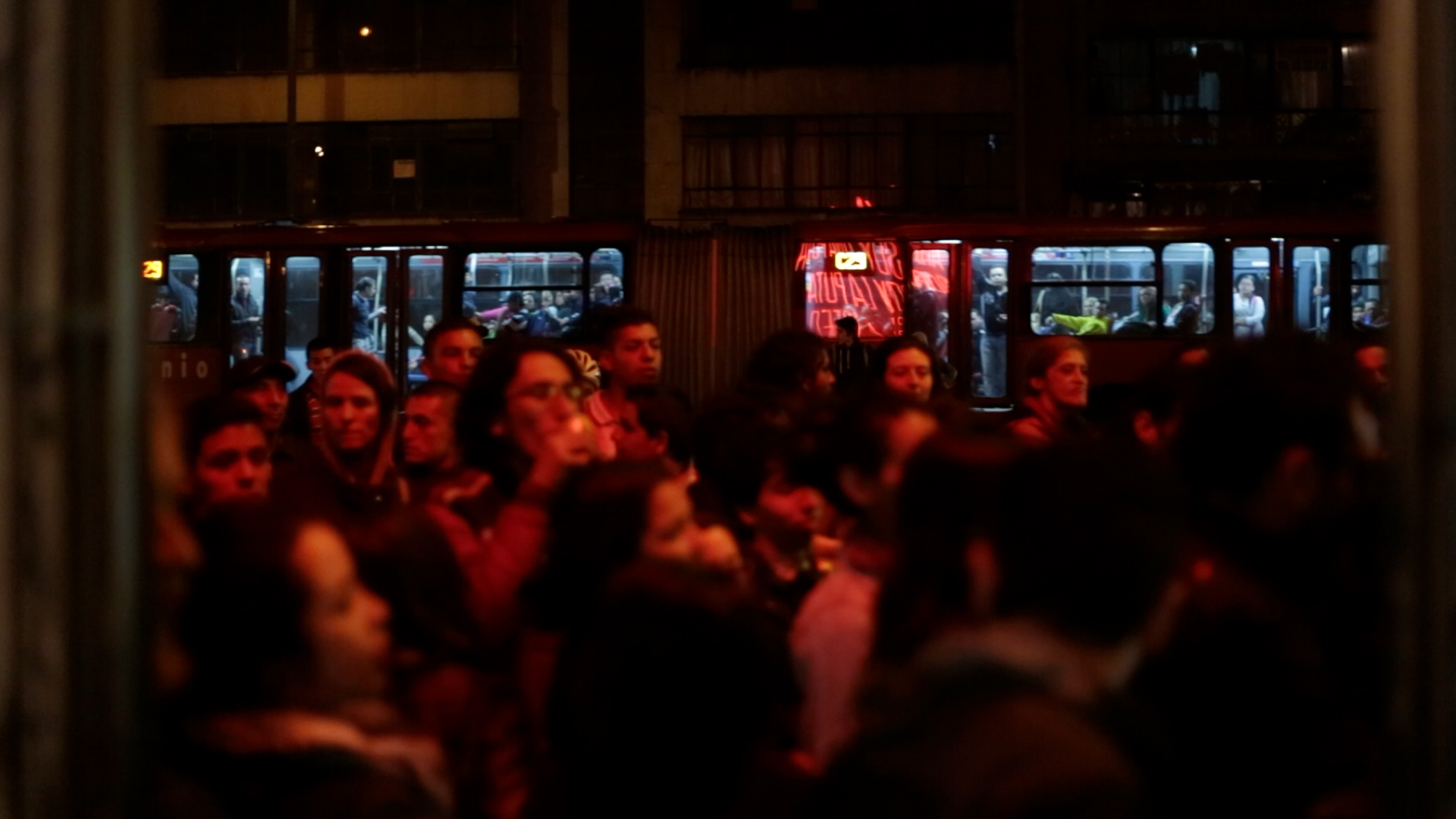
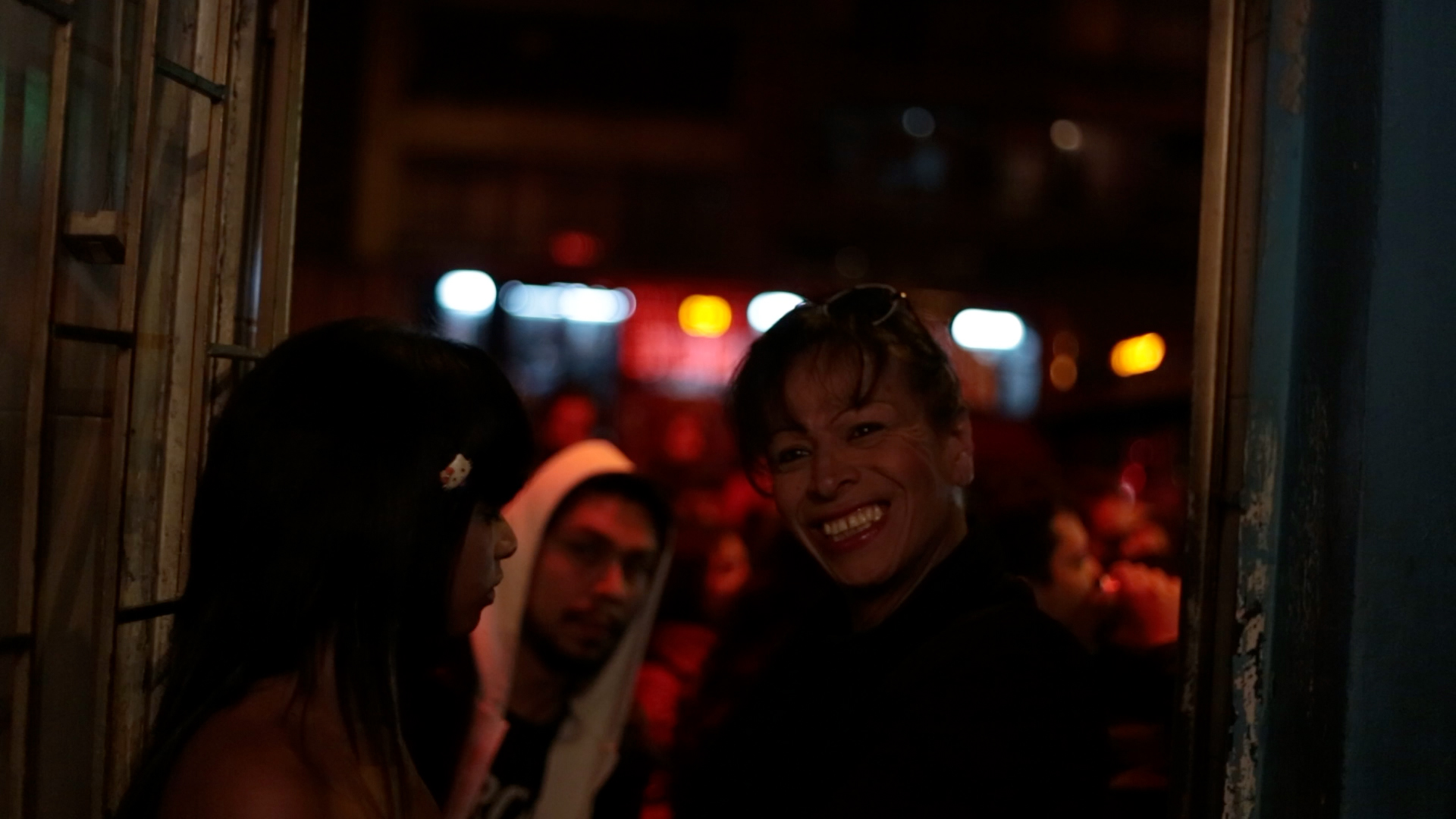






POTENCIAS OF THE BODY
Essay by Marta Cabrera (Fragment)
I arrived in the Santa Fe in November 2014, following the trail of an event posted on social media organized by the art collective CaldodeCultivo, who announced a “cultural take-over” of a border point in the public space that separates the neighborhood from the “rest of the city". Indeed, as one walked along the Avenida Caracas, one began to spot the reddish reflections of an immense neon sign that read "I'm not a whore, I'm the whore, and for you, Ms. Whore” crowning the notorious whorehouse Valparaíso. In addition to the neon, there was a projection on the front of the building, a photographic installation in the entrance corridor, beer for sale, and clothing printing with the "I'm not a whore..." phrase. At dusk, there were interventions by members of organizations that operate in the area and the participants of the project, followed by their performances, and the presentation of some rap groups from the city. As more people joined and began to invade the sidewalk, the take-over came to truly interrupt the activity of the area, slowing the passage of pedestrians and, eventually, the traffic of Avenida Caracas as well. When entering the whorehouse to buy beer, to silkscreen or to use the bathroom there were also unforeseen contacts and exchanges between the heterogeneous group made up of sex workers and their clients, rappers and their fans, locals, artists, activists, and the curious, like the passengers of Transmilenio (public transport system of Bogota) who decided to leave the buses to join the crowd.
One of the most interesting aspects of the take-over is that it was done without notifying or requesting permission from the authorities, resorting instead to the management of the participants themselves and the blessing of the local powers, so that when the police finally came, met by clouds of marijuana smoke and other substances, they chose not to intervene on a joyous crowd and settled for controlling the half-stalled traffic of the Caracas Avenue.
The neon sign, made in the Santa Fe itself, a clear allusion to the aesthetics of the high-impact zone, had been installed the morning of the take-over. From that moment it had begun to emit small waves, tiny atmospheric distortions —and we know that atmospheres are capable of interrupting, disturbing, and enchanting people and places – that set the scene for what was to come. Impressive as they turned out to be, the neon and the take-over were only the tip of the iceberg, the culmination of a four-month-long project that featured a performing arts workshop, a mapping exercise, a video drift, the take-over, and a gallery exhibition. The take-over had a later incarnation in the Valenzuela Klenner gallery, where neon once again lit the walls of an exterior patio, as well as the large-format portraits of some of the participants (who were also present in the exhibition opening), while the video-drift record was projected in another room. This exhibition was held in compliance with the commitments of the IDARTES (District Institute for the Arts) circulation grant that CaldodeCultivo had won, renewing transit between two disparate spaces and many other unforeseen encounters.
The first component, the performance workshop, served to feed the video-derive, which filmed the participants in their places of memory that they had previously indicated in the cartography. They produced representations of themselves and their work, pointing out the importance of the territory in their life trajectories. Finally, the culminating event, the cultural takeover took place on the edge of the Santa Fe neighborhood, on Avenida Caracas and Calle 22, a point that was disrupted by the neon sign with the phrase that gave the project its title, "I am not a whore, I am the whore, and for you, Mrs. Whore." The 5x4 meter neon turned out to be a magnet, a beacon in the gray afternoon, a light streaming through that rift between worlds. The challenging phrase put its protagonists at the center, this time without victimizing overtones or moral panic, radiating from there a polysemic message - a call for attention, a claim, a demand. A small victory.
From the set of activities included in the project, an infinity of personal and collective memories emerged: memories of routes, enclaves, fears, joys, struggles, triumphs and losses, as well as images of this neighborhood where these bodies and these lives are possible, at the same time a place of confinement and refuge, of habitation and work, of activism and violence. Thus, the Santa Fe is a multiple space, where capitalist, sexualized, supervised, contained spaces overlap; a dynamic space, whose constituent processes fluctuate, are continually made and remade. This contradictory codification also points in the direction of the ghetto, a mechanism of social control and confinement that operates through stigma, restriction, spatial confinement, and institutional pigeonholing that maximizes the gains derived from sex work, while avoids the "moral deterioration" of the rest of society by highlighting the border that separates both worlds.
In this context, the take-over was the culmination of a prolonged horizontal encounter between CaldodeCultivo and a diverse group of sex workers in the neighborhood and other actors in an autonomous political action whose atmospheric quality produced spontaneous and random contacts between the bodies of the people attending. It created an entire zone located beyond the usual modes of social control of the neighborhood; a kind of “temporary autonomous zone”, a liminal space that favored the coexistence, at least for a few hours, of disparate and stratified modes of knowledge. The tactic of the take-over may have been ephemeral (as atmospheres can be), but its effects were prolonged in certain affective and corporal niches —like someone who takes home the feeling of having briefly visited another world and can be sure that it exists because he/she was there..
Perhaps we could say that it was possible to prolong the effects of the take-over because it opened a space for utopia, a loophole that revealed multiple possibilities to remake the everyday ordinary worlds of the neighborhood and reveal its complex frameworks. This little world established under the red neon invited us to break with definitive, irreversible, and naturalized ways of seeing the conditions of the environment in order to imagine it again, to make it possible to think with it, and from it. In this reconstructed world, the known and the routine that nested in the practices and spaces of the Santa Fe were revealed, and were simultaneously challenged: their particular stories of gender and sexuality reemerged with force and, although the terrible consequences of planting themselves in the extreme of "bad sex", there were also infinite past and present forms of resistance capable of offering some relief from the uncertainties of the times to come (this was true even when the current pandemic was nowhere in sight). Utopia also requires a body, in whose materiality its potencia resides: “After all, isn't the body of the dancer precisely a body dilated along an entire space that is both exterior and interior to it? And the drugged, also? And the possessed? The possessed, whose bodies become hell; the stigmatized, whose bodies become suffering, redemption and salvation: a bloody paradise.” Bodies as spaces, plastic bodies.
Thus, the other small victory of the takeover, in addition to planting a glorious neon on the site of the stigma, is that it managed to center the attention on a heterogeneous multitude —whores, ñeros, rappers, students, walkers, people of the neighborhood and many more— it opened up the street, turned it into a joyous unusual encounter, tense at times, intoxicating at others, but always open to fantasy; “fantasy is what allows us to imagine ourselves and others otherwise; [...] it points elsewhere, and when it is embodied, it brings the elsewhere home. That is where the potencias of the body reside, of these bodies gathered in that space, intoxicated in a vibrant and transitory atmosphere, reactivated by the forces of affect, contemplating for a short time an infinite horizon of possibilities.

FIAT ARS
PEREAT MUNDUS
ENCUENTRO URGENTE DE RESISTENCIAS ESTÉTICAS ANTE UN MUNDO EN LLAMAS
25.09.2025 — 19:00
24-25.10.2025 — 18:00
Mèdol, Centre d’Arts Contemporànies de Tarragona
Arquitectura Expandida, Democracia, Leónidas Martín, Espectros de lo Urbano, Todo por la Praxis, Tau Luna Acosta, Oscar Guayabero.
Curaduría: CaldodeCultivo
Producción: Künstainer
25.09.2025 — 19:00
24-25.10.2025 — 18:00
Mèdol, Centre d’Arts Contemporànies de Tarragona
Arquitectura Expandida, Democracia, Leónidas Martín, Espectros de lo Urbano, Todo por la Praxis, Tau Luna Acosta, Oscar Guayabero.
Curaduría: CaldodeCultivo
Producción: Künstainer
¿Qué puede el arte ante un mundo en llamas? ¿Qué hacer ante el genocidio en curso, la inminencia de otra guerra mundial, el cataclismo climàtico? ¿Aún es el arte una herramienta o arma eficiente, como defendía Benjamin, con la que dar batalla por la vida digna, cuando no por la misma existencia? ¿Sería este capaz de hacer descarrilar el proyecto neofascista que avanza a toda máquina colonizando el planeta entero?
En el encuentro “Fiat Ars Pereat Mundus” reflexionaremos colectivamente sobre cómo dar respuesta desde las prácticas artísticas a los desafíos existenciales que nos amenazan y atenazan. Para ello, invitamos a artistas con una dilatada experiencia desarrollando prácticas que acompañan y amplifican luchas sociales y políticas, a responder a la sarcástica -y profética- afirmación “Fiat Ars, Pereat Mundus” (Hágase el arte, aunque el mundo perezca), con la que Benjamin denunció la estetización de la política y su complicidad con el fascismo, invitando a combatirla politizando la estética.





CALDODECULTIVO
EJERCICIOS DE RESISTENCIA
Mèdol, Centre d’Arts Contemporànies
de Tarragona, 2025
Dos ediciones independientes:
Español / Català
15.6 × 21.6 cm
352 pág.
Encuadernación Suiza
Cubiertas en serigrafía
ISBN: 978-84-09-66713-0
PVP:27€
+info:
unai@caldodecultivo.com
de Tarragona, 2025
Dos ediciones independientes:
Español / Català
15.6 × 21.6 cm
352 pág.
Encuadernación Suiza
Cubiertas en serigrafía
ISBN: 978-84-09-66713-0
PVP:27€
+info:
unai@caldodecultivo.com
La práctica artística del colectivo CALDODECULTIVO busca fortalecer las luchas que oponen resistencia a la dominación capitalista, colonialista y patriarcal. En sus proyectos despliegan dispositivos de contrapropaganda y agitación popular con los que ejercitar, cual deporte de combate, la imaginación política radical.
Este libro es una narración, a muchas voces, de la experiencia del colectivo a partir de un recorrido por sus proyectos más significativos de la década 2013-2023. En él, además de CALDODECULTIVO, diversxs investigadorxs y activistas reflexionan sobre una práctica artística que es, como se comprobará, necesariamente conflictual.
Aquí se levantan las imágenes de unos proyectos que todavía hoy son afectos y resistencias en movimiento. Si estas páginas logran agitar a quien las lea, con parte de la fuerza con que agitó a quienes vivieron los proyectos, su labor estará hecha.
Unai Reglero y Gabriela Córdoba Vivas
(Ed.) Diana Obando
Ensayos de:
Marta Cabrera, Javier Bassas, Matt Kenyon, Luis Fernando Medina “Luscus”, Halima Afi Cassells, Yolanda Chois Rivera, Andrés Góngora, Jalil Abdul Muntaqim, Fernando Escobar Neir, Katarzyna Pastuszak, Magdalena Mellin & Monika Wińczyk. (Fot.) Guillermo Camacho
Traducció de l’edició en català:
Martí Sales i Carles Serrat
(Ed.) Diana Obando
Ensayos de:
Marta Cabrera, Javier Bassas, Matt Kenyon, Luis Fernando Medina “Luscus”, Halima Afi Cassells, Yolanda Chois Rivera, Andrés Góngora, Jalil Abdul Muntaqim, Fernando Escobar Neir, Katarzyna Pastuszak, Magdalena Mellin & Monika Wińczyk. (Fot.) Guillermo Camacho
Traducció de l’edició en català:
Martí Sales i Carles Serrat
PROJECTS

CARTA BLANCA
Reus, Catalunya (2025)
METROPOLICE
Bogotá DC.(2023)THE ABOLITIONIST
ARTIFACT
Buffalo, New York (2022)
ATTICA NOW
Buffalo, New York (2021-2022)
EVERYTHING
IS GOING TO BE
ALT-RIGHT
Buffalo, New York (2020)

EL COLISEO
DEL PUEBLO
Cali (Colombia), 2018.
LA TOMA
DEL COLISEO
THE STORMING OF THE COLISEUM
Cali (Colombia) 2018

BLACK VENUS
PROTEST
Gdańsk (Poland), 2017.
DETROITERS
Detroit (USA), 2016-2017.
ESTE PREDIO
NO SE VENDE
THIS LAND IS NOT FOR SALEBogotá (Colombia), 2016.

MEDELLIN
SOBRE TODOS
MEDELLIN ÜBER ALLESMedellín (Colombia) 2015—2016
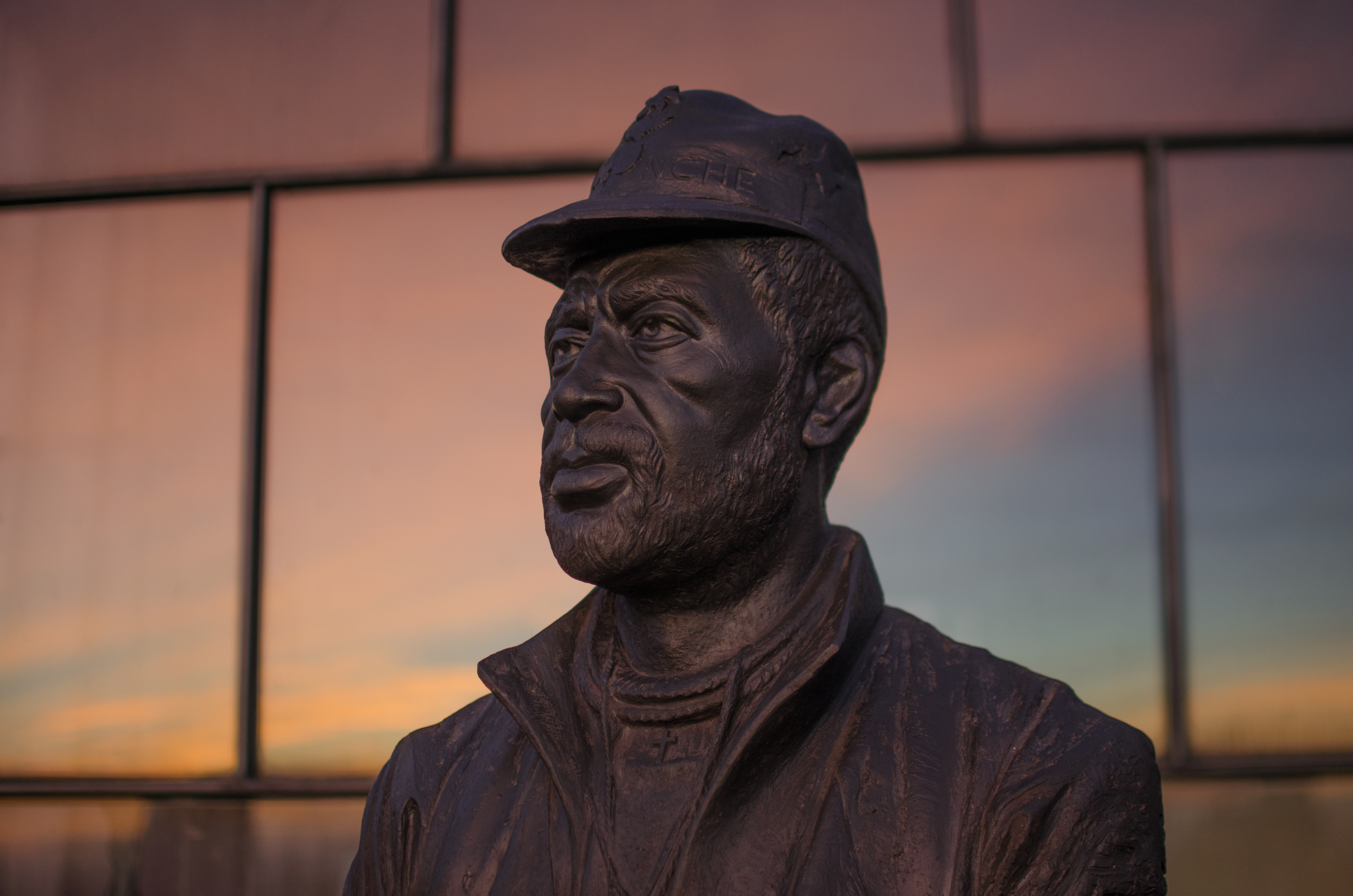
COMANCHE
Bogotá (Colombia) 2015YO NO SOY UNA PUTA
YO SOY LA PUTA
Y PARA USTED:
SEÑORA PUTA
Mrs. WHOREBogotá (Colombia), 2014.

TERRA PROMESA
Tarragona (Spain), 2014.LA TOMA
DEL MAMBO
Bogotá (Colombia), 2018.ARRIBA
LOS DE ABAJO
Bogotá (Colombia), 2013
EUROPA
Warsaw (Poland), 2013
DISTORSIÓN
LIBRE
Tarragona (Spain) 2010-2017

LO IMPORTANTE
ES LA BASE
WHAT MATTER IS THE BASETarragona (Spain) 2013




